It’s been about a year since I started this column. The first of April is right around the corner and I am thinking about beginnings and endings. I felt it time to delve deeper into one of the more enigmatic symbols of Tarot, that of the Fool.
The Fool is interpreted simply in many dissertations on the subject. However, there is much more beneath the surface. I have teased this particular trip down the rabbit hole before, but now it is time to grab our pinafore and go after that púca with the pocket watch.
In most interpretations of this card, it is read more or less literally. It represents idiocy, poor judgement, ignorance, and cupidity. Some variations talk about it as a sign of new beginnings and innocence, but this is a more modern, “New Age” take.
The RWS depiction shows a youth, oblivious to the world around them, about to walk off a cliff. A small dog yaps at their heel. They wear a richly decorated tunic similar to the French Medieval style, a feathered cap, hose and boots, and they carry a leather purse or satchel on the end of a staff. In their left hand they hold a rose. The sun shows wanly in the background, and there are high mountains, indicating that the cliff overlooks a deep ravine and that the drop is most assuredly fatal.
Since this deck, or rather the license infringing Hoi Polloi deck that derives from it, was my first, all later impressions from other decks mentally point back to it. That is, the currents and eddies of the brain invariably take any new (or old) image of the card and compare it to the image as created by Pamela Colman Smith. Therefore the description above identifies the key pieces of that image, and those points for comparison and contrast in other interpretations of the theme. It is those points that I use when contemplating the cards, and teasing the secrets out of them in a reading.
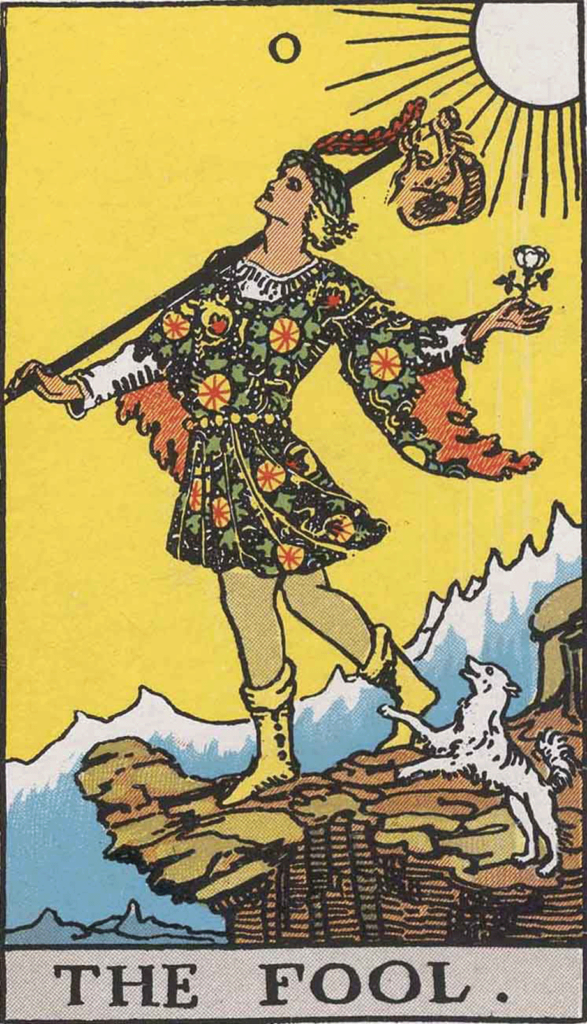
For this reason, the next twenty-one articles in this theme will begin similarly. While I can’t imagine anyone interested in Tarot does not already own some version of the Rider-Waite-Smith deck, it’s also a means of getting everyone on the same page. For good measure I have included a screenshot of each card, which are now in the public domain.
The Fool is also given the number zero, but this has not always been the case. Initially the trumps were not numbered, and then later, only this card was unnumbered, so that in later conventions, it was assumed to have a zero value, when it actually has none. That sounds confusing, I know, but there is a subtle difference between something being given a quantifier, even if that quantity is zero, and something that has no quantifier at all. This is actually a point worth contemplating at length, because in both cases it gives us access to some of the more esoteric messages available to this card.
The somewhat related Eastern ideas of nirvana (quenching), anatta (non-self), and sunyata (emptiness) can be instructive in respect to this subtlety. In many Eastern teachings the ultimate goal of the human spirit is to rise past the need for it’s own identity. Suffering, so it goes, comes from longing, which comes from fear, which comes from the individual ego. When all are one and one are all, there is no need for fear or longing or suffering, and thus the soul is freed from the cycle of reincarnation, because it no longer requires it.
But beyond that, there is a point where none are all and all are none. This is a state where the awareness of the state itself is gone, there is no longer any awareness. This, for lack of a better word, is the void.
Depending on whose philosophy you are reading the void is end or the beginning, the void is a final and immutable state, or it is an intermittent state between cosmological incarnations, because it is inherently unstable, and prone to reasserting its diversity.
In quantum mechanics, physicists talk about things like the Big Bang and the Big Crunch. These represent the opposites ends of all space and time as we perceive it, when everything there is and may be gets pushed into a point so small that no scientifically accurate description can be made of it. The scientists call these points singularities, but because they exist outside the realm of the physics that describe them, they are essentially nothing.
The universe, as the story goes, was without form and void.
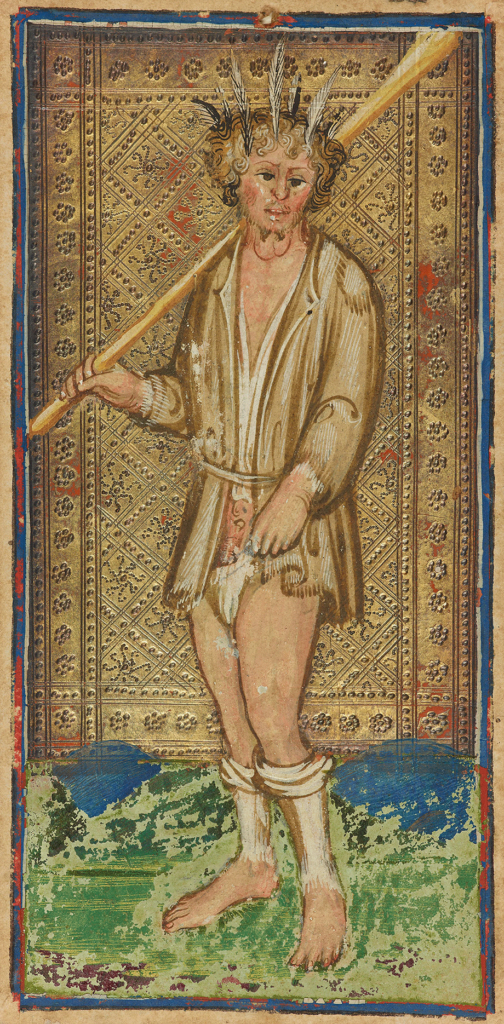
Paul Huson suggests that the images we encounter on the Major Arcana derive from the Medieval mystery pageants that gave rise to our modern theater. If he is correct, the pitiable condition of the Fool in this image may be a metaphor for the bleak condition of the human soul in need of salvation. This attribution of the images resolves a number of questions regarding the inherently Christian content of the trump cards, even though they have been re-interpreted in more secular and pagan ways in the intervening centuries. It is important still to remember that the “book” meaning of Tarot in modern times stems significantly from the works of the occultists Eliphas Levi and Papus, both of whom studied for the priesthood before pursuing their esoteric careers.
There’s a permutation of these theories that says instead of the universe contracting back to a singularity at some point in the distant future, it will continue to expand to the extent that none of the forces of gravity, electromagnetism, or nuclear attraction will hold anything together, and eventually it all just becomes cold and dark and empty. Since none of the physical laws that describe the universe function, the universe itself may be seen to become nothing.
And then there’s the theory that after the universe collapses down to the Big Crunch, it explodes again into another Big Bang in a never ending cycle of time ending and beginning again. Because time and space end at the singularity, the new universe beyond can also be seen to not exist, even though it does.
So he we are, standing on the edge of that cliff, trying to define what the difference is between something that has nothing in it, and nothingness.
Yes, I am still talking about the Fool card.
And the zero which is also a circle. So it is nothing, that has no beginning or ending, completely surrounds nothing within it, and completely excludes everything outside it. It does not exist, yet there is no other.
But from this nothingness all other things must arise. The only way to get something is to have nothing to compare it to. Our numbers all exist as a reference against the value of zero, and zero exists against the value of other.
The light was separated from the darkness. The seas were separated from the dry land.
Things begin. On the edge of a cliff, with a dog yapping at our heels.
That little dog is entropy. It’s the natural tendency of things to fall apart. Stephen Hawking says entropy results in a less organized universe, where the structure and form of matter and energy become more chaotic. The tea cup, he says, always falls off the table and breaks into many pieces. It never reassembles and comes back up because it takes less energy to break it than it does to put it together.
At first glance, that means that our universe is heading for that Big Nothing. But physics also says that after the universe had the Big Bang, things were all sort of the same thing, and it was only because that didn’t stay that way that we got to where we are now. Particles formed as energy transferred from point to point. Forces acted upon the “uneveness” of the particles, and caused them to clump up into bosons and mesons and quarks and atoms and molecules and stars and galaxies. And those got really really big and they fell apart, and then the dust left over and the forces at play swept those clumps together and the process repeated.
We’re basically a second-hand cosmos. Maybe even third-hand.
But apparently that dog keeps chasing us right toward the edge of nothing. Even though it’s going to go over with us. Makes one wonder which one is the Fool here, doesn’t it.
In other versions of the card, the dog (and sometimes tiger or lion) is shown biting the Fool, traditionally read as another sign of their obliviousness to reality. But there’s a second option, and that is the dog is actually trying to stop him from going off the cliff. Like Lassie telling us Little Timmy is in the well, the loyal companion here is looking out for it’s master’s best interests, even if the effort is not wholly appreciated.
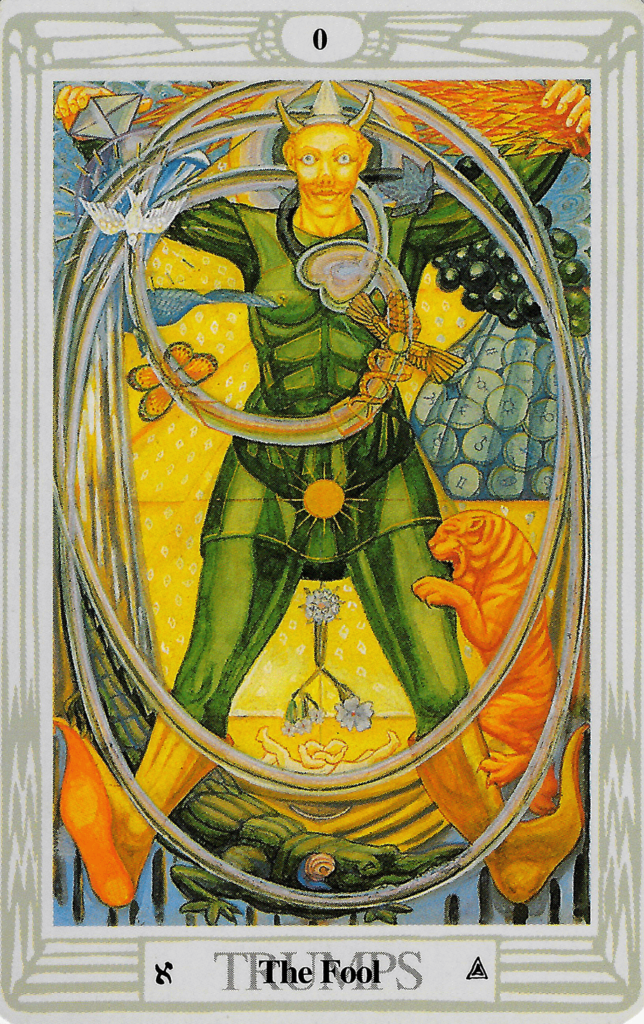
In Medieval symbolism, the dog is frequently portrayed as an emblem of faith. The name often associated with family dogs is “Fido”, from the Latin “fidelis” – Faith. Compare that to the other common epithet of Rover and you can see how the two contrast. It’s a common feature of tomb effigies to show the little dog at the feet of the night or lady. This wasn’t a love of the pet, but a symbol of both marital fidelity and religious piety. Basically, if you showed up at the Pearly Gates with a Fido under your arm you got a pass. Rover, on the other hand, might have to do a turn or two in Purgatory for his indiscretions and philandering nature.
So we can take that and read the Fool’s dog a number of ways. It may be seen as just emblematic of our instincts trying to avert our mistakes. That’s for anything atheists out there, who just dig the pictures on the cards and don’t believe in the spooky weirdness. We can take it up a notch and consider that dog as the presence of higher forces, guardian angels or a divine power, depending on what works for you, that is guiding our forward steps. To the extent that we believe in and rely on such forces comes back to that faith part. Though, finally, we can just consider it a faith in ourselves, the nature of the universe, and the always rushing-forward power that somehow seems to keep all the plates spinning and all the balls in the air. The universe pushes onward because that is what the universe does. It’s part of the mechanism. What it pushes to, and where it pushes from, are completely irrelevant.
That cliff is usually a metaphor for the unknown, whether it be the future, the secrets of the universe, or this week’s winning Lotto numbers. It is the unformed void, the nothing that will become something. It is thus the potential inherent in all beginnings, and in fact all motion, because when we move we are inherently leaving what was and entering what wasn’t. It’s the zero just before it becomes one. It is also the assurance that zero is always going to become one.
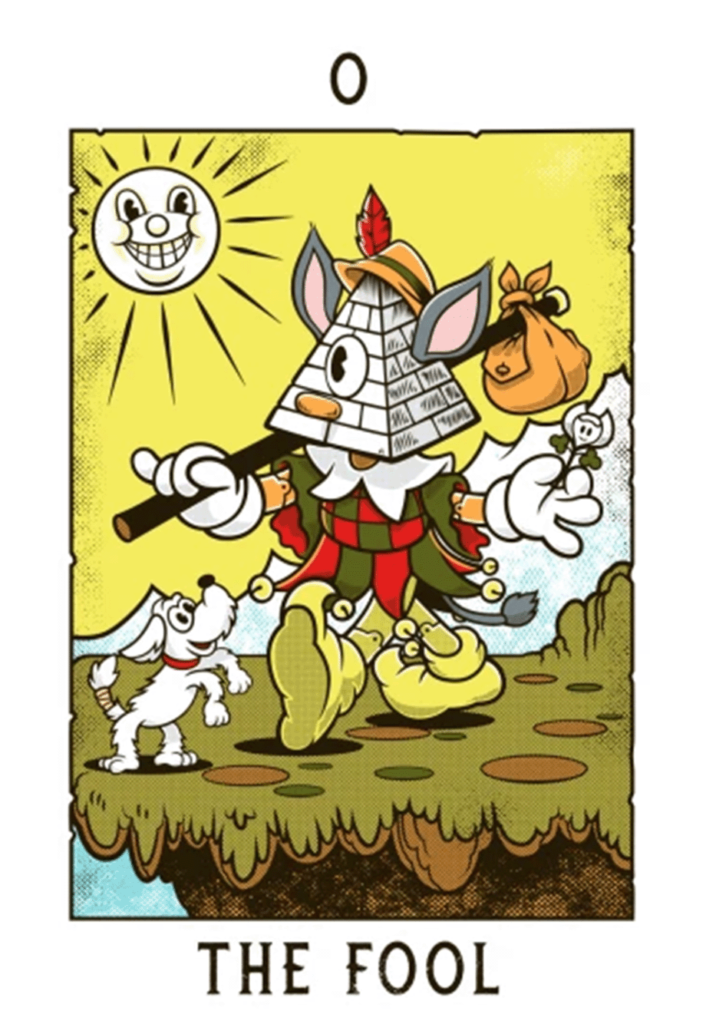
I love this little deck, as both an artist and animator, and a Tarot enthusiast. When I bought it I assumed it would be a very basic pastiche of the RWS cards, but they have incorporated a lot of deep secret stuff in each image. you can find it on the Zon, at B&N, and other Tarot resellers. It may be my favorite of the “new” Tarot decks.
Yet the Fool never steps on the cliff. Yes, I know with a piece of printed cardstock that defies our basic understanding of physics (and that as a metaphor is also worth some contemplation). But it never happens because the future never happens. We simply are in the next moment, and then the next and the next. We experience existence through an eternal present where the past is only a memory, and the future is only a thought. Neither state is really real, only the eternal present, which can be sliced down past minutes to seconds to microseconds and nanoseconds and ad infinitum. has any validity to our senses. We never reach the future. We cannot reach the past either.
This is the ignorance the Fool represents. They cannot know the future because when they get there it is always the present. They are not able to break that pattern. Forward movement is constant, but they never arrive.
These are very troubling ideas. It’s easy to get lost and distracted and give up on understanding any of it. That’s why the sun is behind them. Setting out on the journey here the comfort of the ordinary and the established is put to the side. Once the step is taken onto the path, what was once “true” may not be so ever again.
And very close to the sun in the image is the purse or satchel that the Fool carries with them. We’re familiar with this bag on a stick from numerous illustrations of hobos and vagabonds. It is the sum total of worldly goods that the poor creature owns, bound up in a tiny little bundle. That is, it’s the personal baggage we all carry.
The bundle represents all those things we drag along with us into the future, our identity, our upbringing, our social and cultural suppositions, stereotypes, bigotries, and other limiting factors. It is a small thing, after all, in comparison to the wide potential of all possible futures, but we can’t seem to leave it behind, and it will characterize and color anything that we come across.
The Fool is not “innocence” but “ignorance”. They are blissfully unaware that they carry the package, instead preferring to regard the rose in the other hand, that smells sweeter. This tiny white rose can be seen as a potential for enlightenment and improvement, in balancing the baggage of the past life and poor decisions. As we approach that unknown landscape of the yet to be, we have the choice to rise above the past.
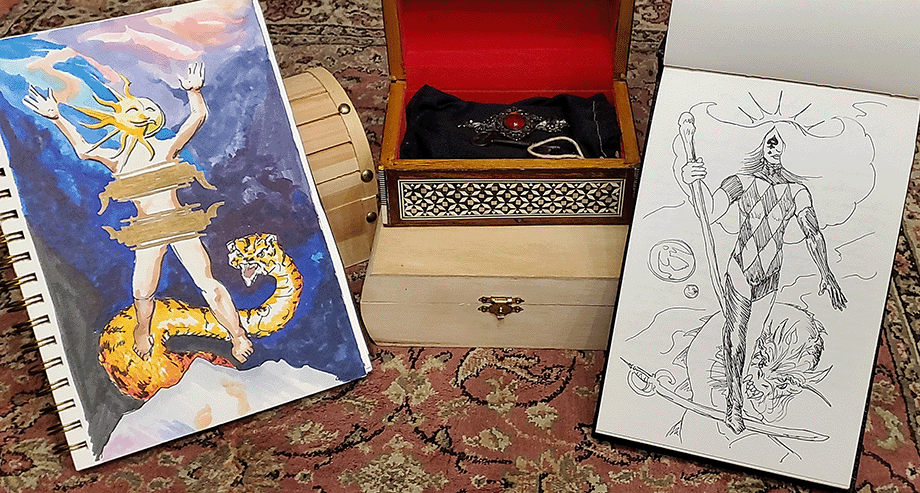
Which is why we find the Fool up in the mountains. Every card in Smith’s designs takes place in a very specific locale. They are, I believe, all happening in a particular land which is as much a part of the Tarot as the key symbols themselves. Like the map just inside a Tolkien book this internal landscape gives us insights into the overall “story” the cards are presenting. It’s not a straightforward, consistent narrative, to be sure, but there are connections to be made. Within the Major Arcana, on the Hermit card is found in similar surroundings. While the Fool represents that raw charge at life with no regard for its dangers, the Hermit is a world weary soul who seeks the true experience of the unknown through a journey of internal contemplation. They are the extrovert and the introvert. The sensualist and the ascetic, yet both inhabit the same rarified air, an air which cannot be occupied constantly or for long periods, without some kind of detriment.
The use of Tarot for non-divinational magic is possibly as old as its more usual role. There are accounts of certain trumps being used in the Renaissance for magic. Often this was limited to the Devil or Tower cards and their aspect to lay malevolent powers upon others. Some speculation has been made that the number of Devils missing from extant decks was because they were used for clandestine veneration by secret witches, but these may be fantastical anecdotes manufactured by the Church, whose relationship with Tarot has always been ambivalent. There are some records indicating that Devil cards were equally employed by parish priests to perform exorcism rites, or otherwise drive the evil out of a place or personage.
Certainly they are potent symbols and their use in sympathetic magic should be obvious to all but the greenest novice. Tarot have been marked, attacked, bundled, buried, and burned. The purpose of the spell governs selection of the card, and method of application. This varies from system to system and tradition to tradition, of course, as do the meanings ascribed to each card, and therefore, its likely efficacy.
The longer one reads with the cards, the more meanings and subtleties may be perceived. The ones I have offered here for the Fool are from my own musings. Doubtless other experienced readers will have differing views. But that green novice may experience a brilliant flash of insight that shocks and amazes us all, because they come to it with fresh eyes.
That is the moment of the Fool. It is the energy of the Big Bang, before it cools to become predictable, quantifiable, and exploitable. It is the fire of pure creativity before it becomes entwined with the conscious control of the artist, who must meld the inspiration with the tool and technique that limits it. It is the raw fury of the Universe, pouring out in a constant roar, before it is tempered and directed by the Magician. It carries within it all that delight and terror that unrestrained chaos offers us.
I personally rarely see the Fool as an emblem of folly and recklessness. There are plenty of other cards in the deck to tell us when we are being idiots. When I see this rise in a reading, I look to how it embraces the future, the possibility of unknown and unknowable factors, and the shaky ground that represents. Cards near to the Fool may be blessed with sudden intuition and brilliance in equal (or unequal) measure with heartache and loss. For creation always carries destruction in her belly. To make a new thing is to destroy the old thing that was before the new thing became.
In this wise, the Fool can also be a death card. They may plummet over the cliff into the abyss. There is nothing to say that the unknown is not Hamlet’s undiscovered country. That is a part of the journey we eventually all experience. The future for all of us is a mortal one, at least in regard to the meat-puppets we pilot merrily along. Beyond that there is only speculation, faith, and myth. If we turn back, and drag our feet, and shy away from the next step, there are consequences. The Fool does rush blindly on, as we all do in a way. Time gives us no respite. Our experience of the universe is a constant forward motion. The little dog is always yapping at our heels.
I hope this article has offered you some new perspectives on this traditionally first of the Major Arcana trumps. I have hinted above at our next adventure, with Card One – The Magician, beginning next week. I hope you will return for it. Thank you again for reading my work.

